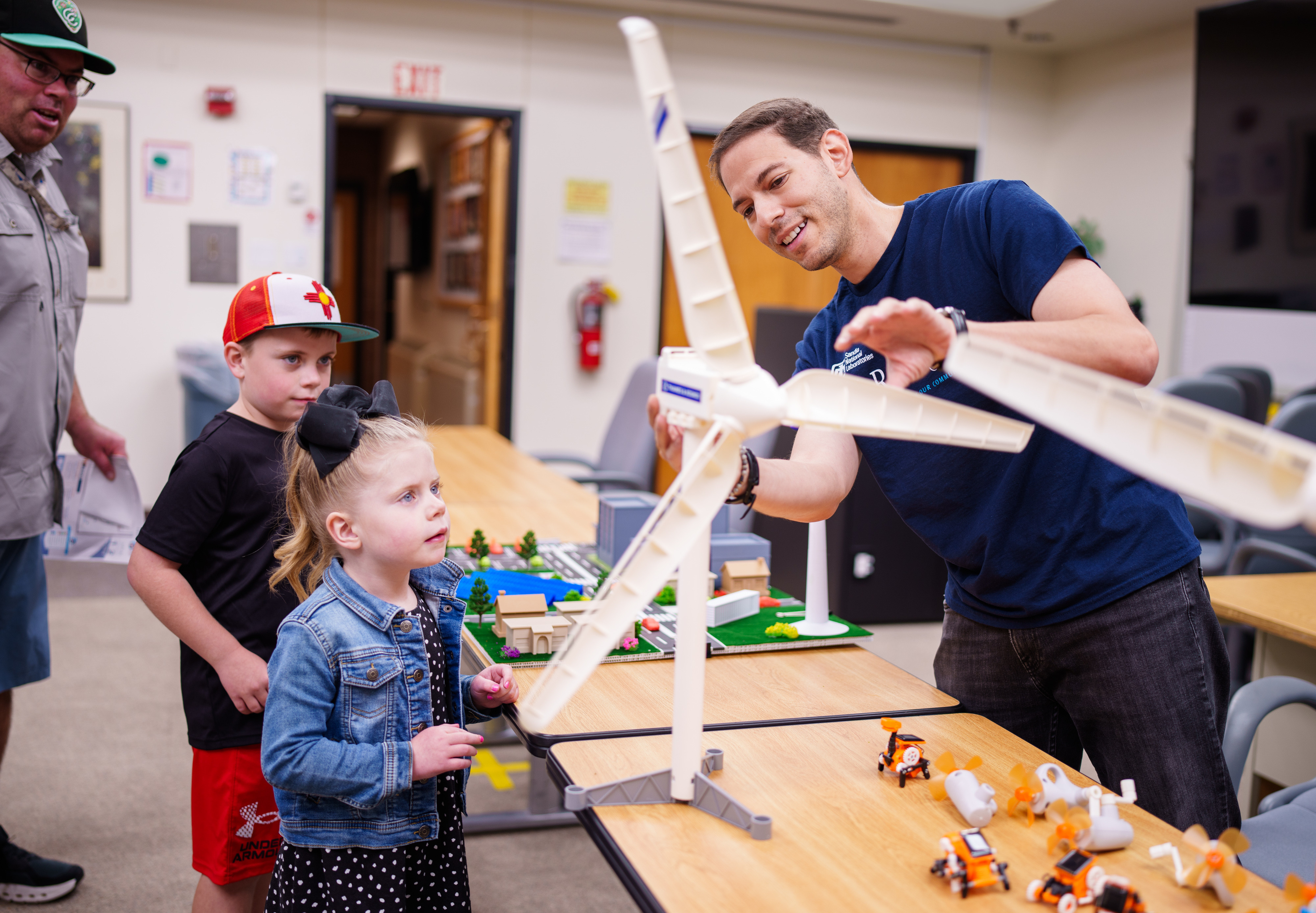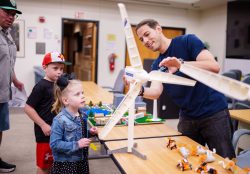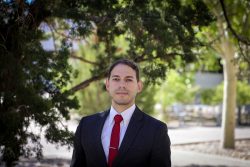
Rachid Darbali-Zamora's career has been defined by two pivotal moments: his introduction to renewable energy at a high school outreach event and his internship at Sandia National Laboratories.

Sandia National Laboratories electrical engineer Rachid Darbali-Zamora, right, shows the power of renewable energy and the microgrid to Alex Riebli and his children Mason, 7, and Addison, 4. Darbali-Zamora has been honored with a Luminary Award by Great Minds in STEM for his technical achievements. (Photo by Craig Fritz) Click on the thumbnail for a high-resolution image.
Darbali-Zamora, now an electrical engineer specializing in microgrids with renewable energy resources at Sandia, has been honored with a Luminary Award by Great Minds in STEM. The award recognizes professionals in science, technology, engineering and mathematics who lead, collaborate and initiate key programs and research in their fields, making significant contributions to the Hispanic technical community as leaders and role models. Darbali-Zamora will receive his award at the 2024 Hispanic Engineer National Achievement Awards Conference in November.
"To me, this award is a call to action," Darbali-Zamora said. "There is more that should be done to help support others in their careers, to make a difference. This is just the beginning of what I hope to accomplish."
Passion for providing "solutions for the little guy"
Darbali-Zamora has always wanted to develop solutions to help others. However, it wasn't until he attended a STEM outreach event at his high school in Jayuya, a small mountainous town in Puerto Rico, and was introduced to renewable energy just 'how' he could help people began to take shape.

Sandia National Laboratories electrical engineer Rachid Darbali-Zamora has been honored with a Luminary Award by Great Minds in STEM for his technical achievements in microgrids with renewable energy resource management. (Photo by Lonnie Anderson) Click on the thumbnail for a high-resolution image.
He earned his bachelor's and master's degrees in electrical engineering from the University of Puerto Rico, Mayagüez Campus, in 2013 and 2016, respectively. He participated in internship programs at Argonne and Pacific Northwest national laboratories, Ohio State University and Wright-Patterson Air Force Base.
In the summer of 2017, Darbali-Zamora interned at Sandia National Laboratories through the Consortium for Integrating Energy Systems in Engineering and Science Education.
"The internship I did at Sandia showed me that here is where I could have the biggest impact," Darbali-Zamora said. "I really wanted to work on projects that provided solutions for the little guy. It was a great experience. The internship helped guide what I wanted to do."
That fall, Hurricane Maria devastated Puerto Rico, causing thousands of deaths and months of power outages for more than 1.5 million people. This tragedy intensified Darbali-Zamora's interest in renewable energy and resiliency. He was hired at Sandia shortly after receiving his doctorate in electrical engineering, energy systems, from UPRM in December 2019.
"When I started, I really wanted to help come up with solutions to help communities in Puerto Rico, because those are the ones that I saw that were really affected by Hurricane María," Darbali-Zamora said. "That's one of the big reasons why I joined Sandia."
Giving back through mentoring and outreach
Shortly after being hired at Sandia, Darbali-Zamora began mentoring students in the successor internship program to the one he participated in. Through the Consortium of Hybrid Resilient Energy Systems program, he has mentored six students and two visiting faculty members from UPRM. He has also mentored seven students through other Sandia internship institutes, five college students through capstone or business development courses, served as a thesis committee member for 10 students and mentored five new Sandia employees.

Sandia National Laboratories electrical engineer Rachid Darbali-Zamora volunteers at Garfield Middle school in Albuquerque New Mexico as part of Hispanic Outreach for Leadership Awareness's Noche de Ciencias. (Photo courtesy of Sandia National Laboratories) Click on the thumbnail for a high-resolution image.
"I am very passionate about my job and research, but where I see the real impact is helping others achieve their goals," Darbali-Zamora said. "You help a postdoc, you help an intern, or you help a graduate student; that is a very direct impact. It is very much time well spent."
Darbali-Zamora is involved in Sandia's Hispanic Outreach for Leadership and Awareness employee resource group, particularly their STEM outreach event Noche de Ciencias. These bilingual family science events aim to get middle- and high-school minority students and their parents interested in STEM while highlighting the value of staying in school.
He also participates in other Sandia-led STEM outreach activities for students in middle school through high school, such as Meet a Scientist Day, Earth Day demonstrations and summer camps.
"There were a few outreach activities at my high school that got me really interested in engineering," Darbali-Zamora said. "If you have a room full of 30 students and at least one of them is captivated by what you're showing and it motivates them, then that makes it worthwhile."
Developing microgrids for home and space
One of the research projects Darbali-Zamora is most proud of is the Wind Hybrid Integration Platform, funded by the Department of Energy's Wind Energy Technologies Office. This project focuses on developing a management system for power systems and microgrids with solar, wind and energy storage resources. The team tested the management system using Sandia's power hardware-in-the-loop platform with simulations mimicking power systems in Puerto Rico, Alaska, and Texas.
"The WHIP project has given me a really good opportunity to do all of the things that drove me to Sandia, such as engaging and interacting with community members and working with partners at the University of Puerto Rico," Darbali-Zamora said.
Darbali-Zamora is also excited about a recently funded Office of Electricity project to design a microgrid controller that will use artificial intelligence to optimize the configuration of the microgrid and ensure equitable access to electricity, even with large amounts of variable renewable energy resources. He plans to work with communities in Puerto Rico, pueblos in New Mexico and Alaskan Native tribes as part of this project.
A microgrid links buildings and power sources, such as photovoltaics or diesel generators, to create small "islands" of power if the main electrical grid fails. These systems are often designed around critical infrastructure like hospitals and water treatment plants, enhancing community resilience against natural disasters.
In addition to these projects, he has also been involved in several Federal Emergency Management Agency-funded initiatives to explore possible locations for microgrids in Puerto Rico to improve post-hurricane resiliency and work with partners at UPRM to provide training and workshops on Sandia's microgrid design tools to support local workforce development efforts.
Darbali-Zamora's expertise in microgrids extends beyond Earth. He was part of a Sandia team that worked with NASA to design a DC microgrid for the future Artemis lunar base.
Darbali-Zamora has published over 100 research papers and holds several patents. As an adjunct professor at UPRM, he supports students in their graduate studies.
"Helping other people grow is critical," Darbali-Zamora said. "When you're starting in your career, you're probably the one being helped. As you advance, being able to help, mentor and provide support is vital. It's very easy to be distracted by proposals and papers, but it's really important to guide others in their journey."
Sandia National Laboratories is a multimission laboratory operated by National Technology and Engineering Solutions of Sandia LLC, a wholly owned subsidiary of Honeywell International Inc., for the U.S. Department of Energy's National Nuclear Security Administration. Sandia Labs has major research and development responsibilities in nuclear deterrence, global security, defense, energy technologies and economic competitiveness, with main facilities in Albuquerque, New Mexico, and Livermore, California.






